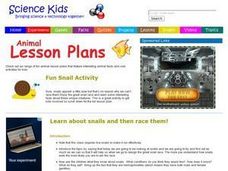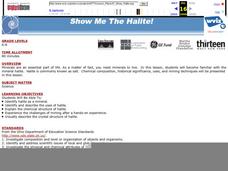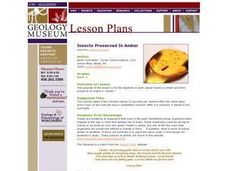Curated OER
Animals Must Fit In
A instructional activity on tadpoles is here for your young biologists. Learners read a short paragraph on tadpoles, then answer three questions regarding how parts of their bodies help the tadpole to survive in the pond. There is a good...
LABScI
The Separation Lab: Candy Colors
There's no better motivator than candy! An engaging activity has pupils explore methods for separating mixtures. A two-part lab first explores methods of separation based on size and magnetism. The second activity introduces learners to...
Curated OER
Habitats of the Pond
Students explore biology by researching habitats for organisms. In this water environment lesson, students utilize a magnifying glass to examine the different organisms that live on a nearby pond or lake and explore their habitats....
Curated OER
Learn about snails and then race them!
Learners examine snails and make observations about where their eyes are located, how they eat, and how they move. In this snails lesson, students discover information about snails by observing them. Learners use magnifying glass, a...
Curated OER
What is in Soil?
Fourth graders identify and examine the components that make up soil. Individually, they use a magnifying glass to identify the organic and inorganic material in their soil sample. To end the lesson, they record the differences in the...
Exploratorium
Water Sphere Lens
With a Florence flask or fishbowl, make a double convex lens and use it to examine an image. Because of the refraction, the image will be inverted. A simple explanation is provided here for you to share with your class as they...
Science Friday
Ugh, a Bug!
Young entomologists familiarize themselves with the physical characteristics of insects. Composed of two activities, each lesson involves your scientists tapping into their prior knowledge of bugs and making observations of real live...
Curated OER
Stator limbatus Study, Part 1
Second graders experiment identifying beetle emergence and exit holes in seeds, count them, look for beetle eggs with a magnifier and count how many beetle eggs they find. They then graph on a data sheet the findings from their research.
Curated OER
Earth, Sun and Moon
Students explore, experiment and study how the Earth orbits the Sun once a year and how the moon takes approximately 29 days to orbit the Earth. They access an online activity to examine the process of how the Sun is at the center of the...
Curated OER
Related Lessons Animal
Students examine the extinction of dinosaurs. In this dinosaur instructional activity students create their own dinosaur eggs, get into groups and complete a diorama activity.
Curated OER
Insect Matching
Third graders match insects to the proper order based on the characteristics. They culminate their study of the orders that insects belong in by looking at insects with magnifying glasses.
Curated OER
A Distant View
Students investigate the essential concepts of how lenses work to magnify vision, and then build simple telescopes to demonstrate their understanding. They write a description of how their telescope could be improved and how it works.
Curated OER
The Virtual Electron Microscope
Students explore the world of the very small using a Flash plug-in Virtual Electron Microscope. They complete and discuss an activity in which unknown samples are placed under the computer simulated microscope to determine where the...
Curated OER
Are You Ready to Rock?
Second graders investigate rock samples using magnifying class. In this earth science lesson, 2nd graders identify the physical properties and describe them verbally with their partners. They compare their findings with the class.
Curated OER
Seed Sorting
Young scholars examine and sort seeds. In this life science lesson, students make general observations of a tub of seeds, then develop sorting criteria for sorting the deeds. Lesson includes extension activities.
Curated OER
Wigglers, Tumblers, & Bloodsuckers
Students explore the life stages of a mosquito. In this animal biology lesson, students read Why Mosquitoes Buzz in People's Ears by Verna Aardema and complete several activities including an experiment with mosquito larvae, an activity...
Curated OER
Uniquely Leaves
Fourth graders study the uniquely diverse structural design of leaves and demonstrate knowledge of interdependence between structure and environment through research, laboratory activity and written summary.
Curated OER
Who's in my soil!?!...and just what do they think they're doing there?
Students discover organisms that inhabit the soil, the beneficial an detrimental roles these organisms play, and the interactions between the organisms and their environment and other organisms. Students participate in four hands-on ...
Curated OER
Seed Socks
Young scholars explore how seeds travel. In this seed disbursement lesson, students head outside in their bare socks. Young scholars walk around then before going inside they take the socks off and examine what their socks picked up. As...
Curated OER
"Five Little Seeds"
Fourth graders complete various activities related to the plant life cycle. They read the book "The Tiny Seed," read and discuss the poem "Five Little Seeds," complete a "Plantenstein Mystery" and other online activities, write and...
Curated OER
Show Me the Halite!
Introduce middle school mineralologists to halite. The opening of the lesson involves a video and worksheet to which there are no links. However, you can replace the video with any informational clip that you can find online about halite...
Curated OER
Insect Investigator
Students examine and identify common insects. They observe these insects in their environment and keep track of how many they see. They use magnifying glasses and special hats to get into the role of an inspector.
Curated OER
The Life Cycle of the Butterfly
Students examine the life of a butterfly. They write a biography from the point of view of a caterpillar using new vocabulary. They use magnifying glasses to examine butterflies and caterpillars.
Curated OER
Insects Preserved in Amber
Students examine and discuss amber and fossils in amber. They simulate the preservation of an insect in amber using glue, a dead insect, and food coloring, listen to a poem about amber, and view real amber under a magnifying glass or...

























